Business Process Management Analysis Report: BPM Capabilities
VerifiedAdded on 2020/04/01
|10
|2616
|50
Report
AI Summary
This report provides a comprehensive review of a paper by Lehnert, Linhart, and Röglinger, focusing on balancing the development of Business Process Management (BPM) capabilities with process improvement. The report analyzes the research methods employed, specifically the grounded theory approach and decision model, and highlights key findings, including the differentiation between process-level and BPM-level project archetypes. It examines the integration of project effects into an objective function and discusses the application of value-based management principles. The report also explores the strengths of the paper, drawing support from related studies on BPM lifecycle stages, project portfolio selection, and performance measurement. Furthermore, the report delves into the authors' arguments concerning optimal BPM roadmaps, project selection, and the impact of temporal interactions on output value. The conclusion emphasizes the importance of BPM in overseeing organizational performance and driving consistent outcomes while identifying opportunities for improvement.

Business Process Engineering
Assignment 2
Student Name:
Student Number:
Module Code:
Submission Date:
STUDENT NAME: STUDENT NUMBER: 1
Assignment 2
Student Name:
Student Number:
Module Code:
Submission Date:
STUDENT NAME: STUDENT NUMBER: 1
Paraphrase This Document
Need a fresh take? Get an instant paraphrase of this document with our AI Paraphraser
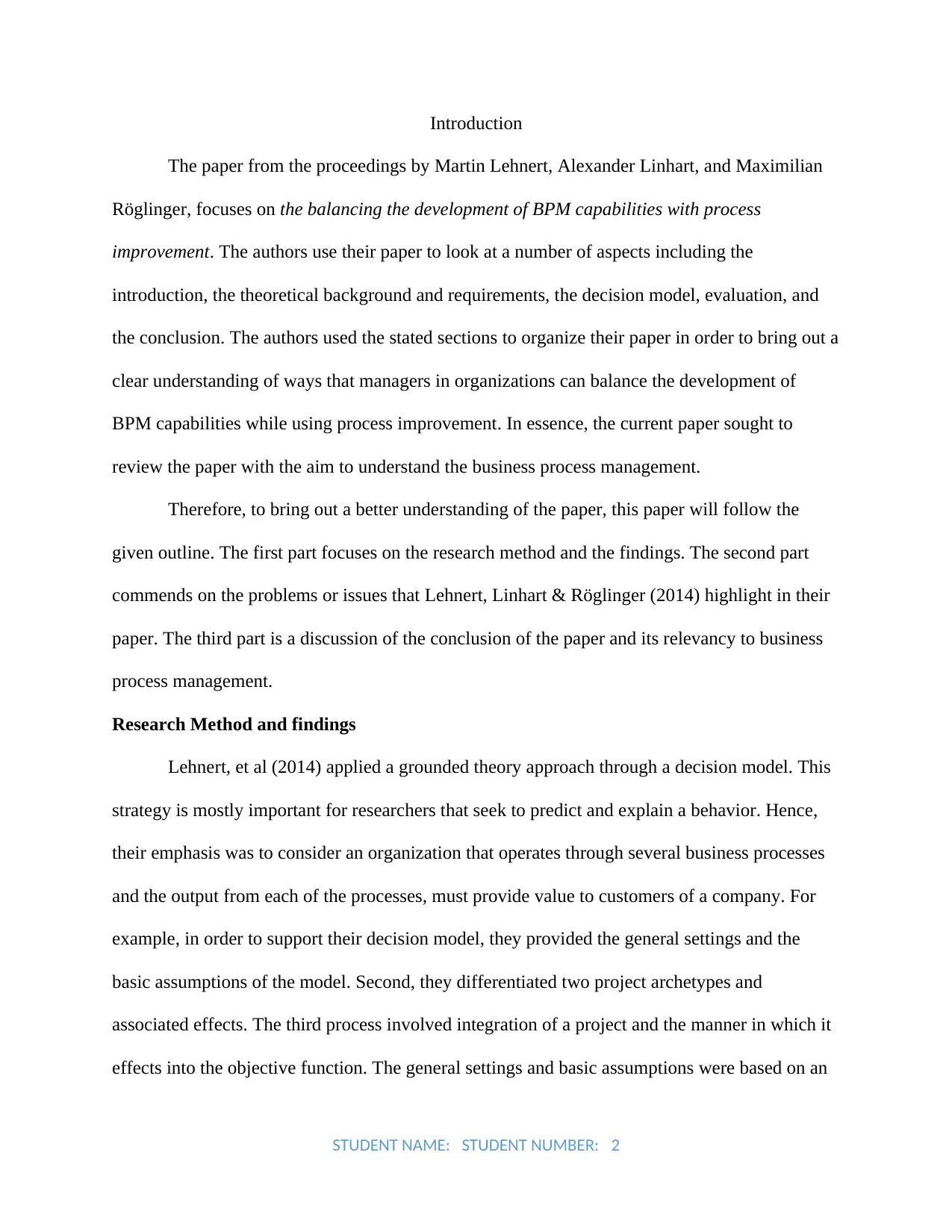
Introduction
The paper from the proceedings by Martin Lehnert, Alexander Linhart, and Maximilian
Röglinger, focuses on the balancing the development of BPM capabilities with process
improvement. The authors use their paper to look at a number of aspects including the
introduction, the theoretical background and requirements, the decision model, evaluation, and
the conclusion. The authors used the stated sections to organize their paper in order to bring out a
clear understanding of ways that managers in organizations can balance the development of
BPM capabilities while using process improvement. In essence, the current paper sought to
review the paper with the aim to understand the business process management.
Therefore, to bring out a better understanding of the paper, this paper will follow the
given outline. The first part focuses on the research method and the findings. The second part
commends on the problems or issues that Lehnert, Linhart & Röglinger (2014) highlight in their
paper. The third part is a discussion of the conclusion of the paper and its relevancy to business
process management.
Research Method and findings
Lehnert, et al (2014) applied a grounded theory approach through a decision model. This
strategy is mostly important for researchers that seek to predict and explain a behavior. Hence,
their emphasis was to consider an organization that operates through several business processes
and the output from each of the processes, must provide value to customers of a company. For
example, in order to support their decision model, they provided the general settings and the
basic assumptions of the model. Second, they differentiated two project archetypes and
associated effects. The third process involved integration of a project and the manner in which it
effects into the objective function. The general settings and basic assumptions were based on an
STUDENT NAME: STUDENT NUMBER: 2
The paper from the proceedings by Martin Lehnert, Alexander Linhart, and Maximilian
Röglinger, focuses on the balancing the development of BPM capabilities with process
improvement. The authors use their paper to look at a number of aspects including the
introduction, the theoretical background and requirements, the decision model, evaluation, and
the conclusion. The authors used the stated sections to organize their paper in order to bring out a
clear understanding of ways that managers in organizations can balance the development of
BPM capabilities while using process improvement. In essence, the current paper sought to
review the paper with the aim to understand the business process management.
Therefore, to bring out a better understanding of the paper, this paper will follow the
given outline. The first part focuses on the research method and the findings. The second part
commends on the problems or issues that Lehnert, Linhart & Röglinger (2014) highlight in their
paper. The third part is a discussion of the conclusion of the paper and its relevancy to business
process management.
Research Method and findings
Lehnert, et al (2014) applied a grounded theory approach through a decision model. This
strategy is mostly important for researchers that seek to predict and explain a behavior. Hence,
their emphasis was to consider an organization that operates through several business processes
and the output from each of the processes, must provide value to customers of a company. For
example, in order to support their decision model, they provided the general settings and the
basic assumptions of the model. Second, they differentiated two project archetypes and
associated effects. The third process involved integration of a project and the manner in which it
effects into the objective function. The general settings and basic assumptions were based on an
STUDENT NAME: STUDENT NUMBER: 2
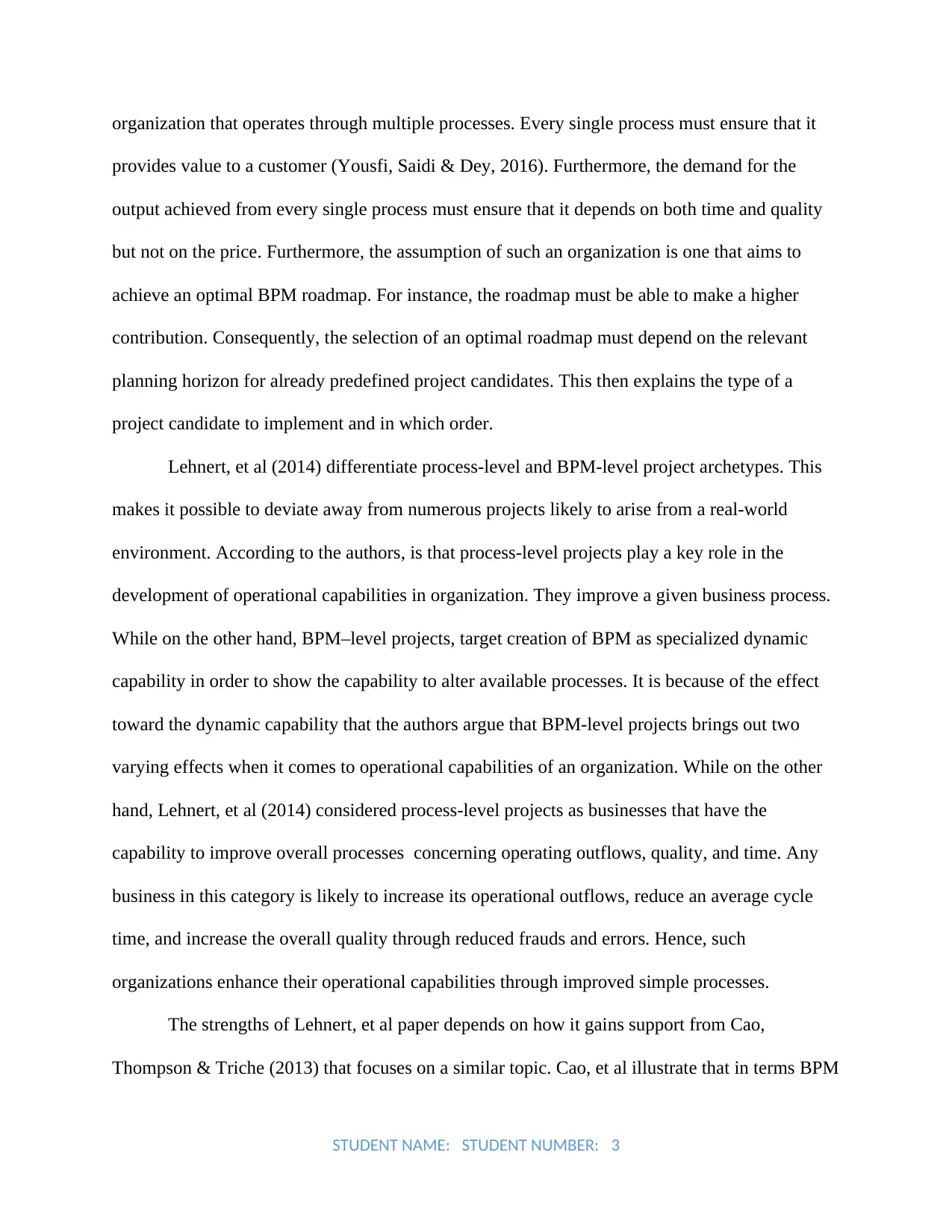
organization that operates through multiple processes. Every single process must ensure that it
provides value to a customer (Yousfi, Saidi & Dey, 2016). Furthermore, the demand for the
output achieved from every single process must ensure that it depends on both time and quality
but not on the price. Furthermore, the assumption of such an organization is one that aims to
achieve an optimal BPM roadmap. For instance, the roadmap must be able to make a higher
contribution. Consequently, the selection of an optimal roadmap must depend on the relevant
planning horizon for already predefined project candidates. This then explains the type of a
project candidate to implement and in which order.
Lehnert, et al (2014) differentiate process-level and BPM-level project archetypes. This
makes it possible to deviate away from numerous projects likely to arise from a real-world
environment. According to the authors, is that process-level projects play a key role in the
development of operational capabilities in organization. They improve a given business process.
While on the other hand, BPM–level projects, target creation of BPM as specialized dynamic
capability in order to show the capability to alter available processes. It is because of the effect
toward the dynamic capability that the authors argue that BPM-level projects brings out two
varying effects when it comes to operational capabilities of an organization. While on the other
hand, Lehnert, et al (2014) considered process-level projects as businesses that have the
capability to improve overall processes concerning operating outflows, quality, and time. Any
business in this category is likely to increase its operational outflows, reduce an average cycle
time, and increase the overall quality through reduced frauds and errors. Hence, such
organizations enhance their operational capabilities through improved simple processes.
The strengths of Lehnert, et al paper depends on how it gains support from Cao,
Thompson & Triche (2013) that focuses on a similar topic. Cao, et al illustrate that in terms BPM
STUDENT NAME: STUDENT NUMBER: 3
provides value to a customer (Yousfi, Saidi & Dey, 2016). Furthermore, the demand for the
output achieved from every single process must ensure that it depends on both time and quality
but not on the price. Furthermore, the assumption of such an organization is one that aims to
achieve an optimal BPM roadmap. For instance, the roadmap must be able to make a higher
contribution. Consequently, the selection of an optimal roadmap must depend on the relevant
planning horizon for already predefined project candidates. This then explains the type of a
project candidate to implement and in which order.
Lehnert, et al (2014) differentiate process-level and BPM-level project archetypes. This
makes it possible to deviate away from numerous projects likely to arise from a real-world
environment. According to the authors, is that process-level projects play a key role in the
development of operational capabilities in organization. They improve a given business process.
While on the other hand, BPM–level projects, target creation of BPM as specialized dynamic
capability in order to show the capability to alter available processes. It is because of the effect
toward the dynamic capability that the authors argue that BPM-level projects brings out two
varying effects when it comes to operational capabilities of an organization. While on the other
hand, Lehnert, et al (2014) considered process-level projects as businesses that have the
capability to improve overall processes concerning operating outflows, quality, and time. Any
business in this category is likely to increase its operational outflows, reduce an average cycle
time, and increase the overall quality through reduced frauds and errors. Hence, such
organizations enhance their operational capabilities through improved simple processes.
The strengths of Lehnert, et al paper depends on how it gains support from Cao,
Thompson & Triche (2013) that focuses on a similar topic. Cao, et al illustrate that in terms BPM
STUDENT NAME: STUDENT NUMBER: 3
⊘ This is a preview!⊘
Do you want full access?
Subscribe today to unlock all pages.

Trusted by 1+ million students worldwide
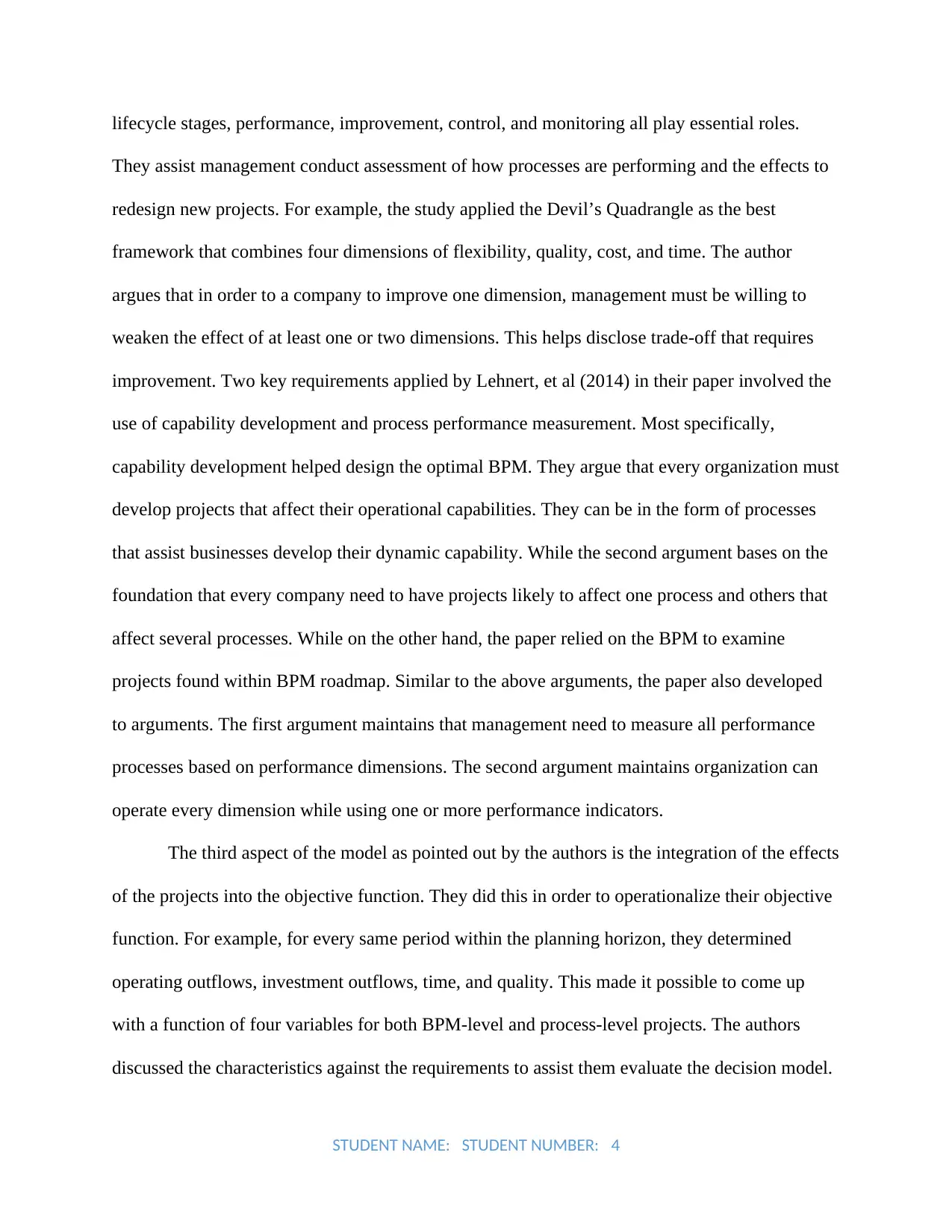
lifecycle stages, performance, improvement, control, and monitoring all play essential roles.
They assist management conduct assessment of how processes are performing and the effects to
redesign new projects. For example, the study applied the Devil’s Quadrangle as the best
framework that combines four dimensions of flexibility, quality, cost, and time. The author
argues that in order to a company to improve one dimension, management must be willing to
weaken the effect of at least one or two dimensions. This helps disclose trade-off that requires
improvement. Two key requirements applied by Lehnert, et al (2014) in their paper involved the
use of capability development and process performance measurement. Most specifically,
capability development helped design the optimal BPM. They argue that every organization must
develop projects that affect their operational capabilities. They can be in the form of processes
that assist businesses develop their dynamic capability. While the second argument bases on the
foundation that every company need to have projects likely to affect one process and others that
affect several processes. While on the other hand, the paper relied on the BPM to examine
projects found within BPM roadmap. Similar to the above arguments, the paper also developed
to arguments. The first argument maintains that management need to measure all performance
processes based on performance dimensions. The second argument maintains organization can
operate every dimension while using one or more performance indicators.
The third aspect of the model as pointed out by the authors is the integration of the effects
of the projects into the objective function. They did this in order to operationalize their objective
function. For example, for every same period within the planning horizon, they determined
operating outflows, investment outflows, time, and quality. This made it possible to come up
with a function of four variables for both BPM-level and process-level projects. The authors
discussed the characteristics against the requirements to assist them evaluate the decision model.
STUDENT NAME: STUDENT NUMBER: 4
They assist management conduct assessment of how processes are performing and the effects to
redesign new projects. For example, the study applied the Devil’s Quadrangle as the best
framework that combines four dimensions of flexibility, quality, cost, and time. The author
argues that in order to a company to improve one dimension, management must be willing to
weaken the effect of at least one or two dimensions. This helps disclose trade-off that requires
improvement. Two key requirements applied by Lehnert, et al (2014) in their paper involved the
use of capability development and process performance measurement. Most specifically,
capability development helped design the optimal BPM. They argue that every organization must
develop projects that affect their operational capabilities. They can be in the form of processes
that assist businesses develop their dynamic capability. While the second argument bases on the
foundation that every company need to have projects likely to affect one process and others that
affect several processes. While on the other hand, the paper relied on the BPM to examine
projects found within BPM roadmap. Similar to the above arguments, the paper also developed
to arguments. The first argument maintains that management need to measure all performance
processes based on performance dimensions. The second argument maintains organization can
operate every dimension while using one or more performance indicators.
The third aspect of the model as pointed out by the authors is the integration of the effects
of the projects into the objective function. They did this in order to operationalize their objective
function. For example, for every same period within the planning horizon, they determined
operating outflows, investment outflows, time, and quality. This made it possible to come up
with a function of four variables for both BPM-level and process-level projects. The authors
discussed the characteristics against the requirements to assist them evaluate the decision model.
STUDENT NAME: STUDENT NUMBER: 4
Paraphrase This Document
Need a fresh take? Get an instant paraphrase of this document with our AI Paraphraser
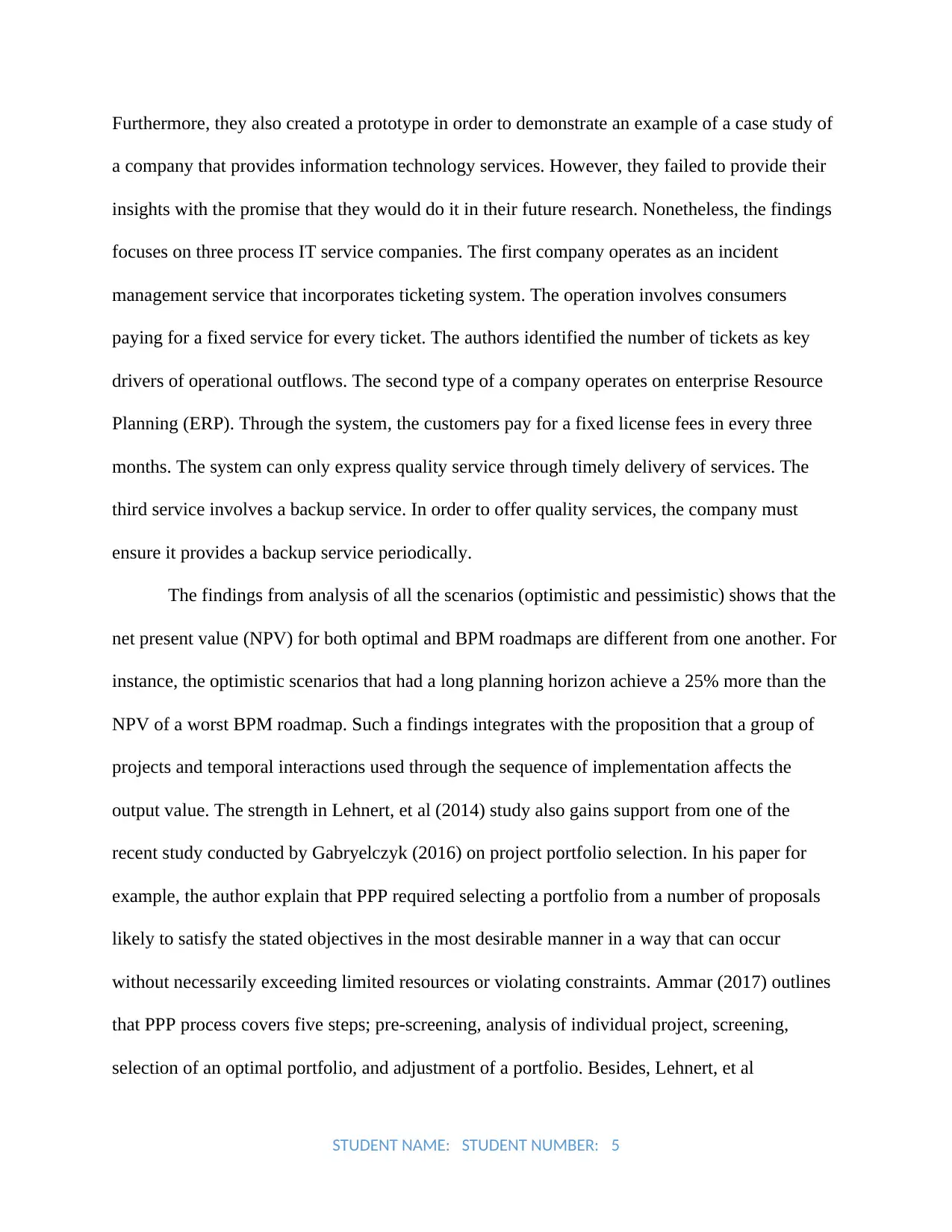
Furthermore, they also created a prototype in order to demonstrate an example of a case study of
a company that provides information technology services. However, they failed to provide their
insights with the promise that they would do it in their future research. Nonetheless, the findings
focuses on three process IT service companies. The first company operates as an incident
management service that incorporates ticketing system. The operation involves consumers
paying for a fixed service for every ticket. The authors identified the number of tickets as key
drivers of operational outflows. The second type of a company operates on enterprise Resource
Planning (ERP). Through the system, the customers pay for a fixed license fees in every three
months. The system can only express quality service through timely delivery of services. The
third service involves a backup service. In order to offer quality services, the company must
ensure it provides a backup service periodically.
The findings from analysis of all the scenarios (optimistic and pessimistic) shows that the
net present value (NPV) for both optimal and BPM roadmaps are different from one another. For
instance, the optimistic scenarios that had a long planning horizon achieve a 25% more than the
NPV of a worst BPM roadmap. Such a findings integrates with the proposition that a group of
projects and temporal interactions used through the sequence of implementation affects the
output value. The strength in Lehnert, et al (2014) study also gains support from one of the
recent study conducted by Gabryelczyk (2016) on project portfolio selection. In his paper for
example, the author explain that PPP required selecting a portfolio from a number of proposals
likely to satisfy the stated objectives in the most desirable manner in a way that can occur
without necessarily exceeding limited resources or violating constraints. Ammar (2017) outlines
that PPP process covers five steps; pre-screening, analysis of individual project, screening,
selection of an optimal portfolio, and adjustment of a portfolio. Besides, Lehnert, et al
STUDENT NAME: STUDENT NUMBER: 5
a company that provides information technology services. However, they failed to provide their
insights with the promise that they would do it in their future research. Nonetheless, the findings
focuses on three process IT service companies. The first company operates as an incident
management service that incorporates ticketing system. The operation involves consumers
paying for a fixed service for every ticket. The authors identified the number of tickets as key
drivers of operational outflows. The second type of a company operates on enterprise Resource
Planning (ERP). Through the system, the customers pay for a fixed license fees in every three
months. The system can only express quality service through timely delivery of services. The
third service involves a backup service. In order to offer quality services, the company must
ensure it provides a backup service periodically.
The findings from analysis of all the scenarios (optimistic and pessimistic) shows that the
net present value (NPV) for both optimal and BPM roadmaps are different from one another. For
instance, the optimistic scenarios that had a long planning horizon achieve a 25% more than the
NPV of a worst BPM roadmap. Such a findings integrates with the proposition that a group of
projects and temporal interactions used through the sequence of implementation affects the
output value. The strength in Lehnert, et al (2014) study also gains support from one of the
recent study conducted by Gabryelczyk (2016) on project portfolio selection. In his paper for
example, the author explain that PPP required selecting a portfolio from a number of proposals
likely to satisfy the stated objectives in the most desirable manner in a way that can occur
without necessarily exceeding limited resources or violating constraints. Ammar (2017) outlines
that PPP process covers five steps; pre-screening, analysis of individual project, screening,
selection of an optimal portfolio, and adjustment of a portfolio. Besides, Lehnert, et al
STUDENT NAME: STUDENT NUMBER: 5
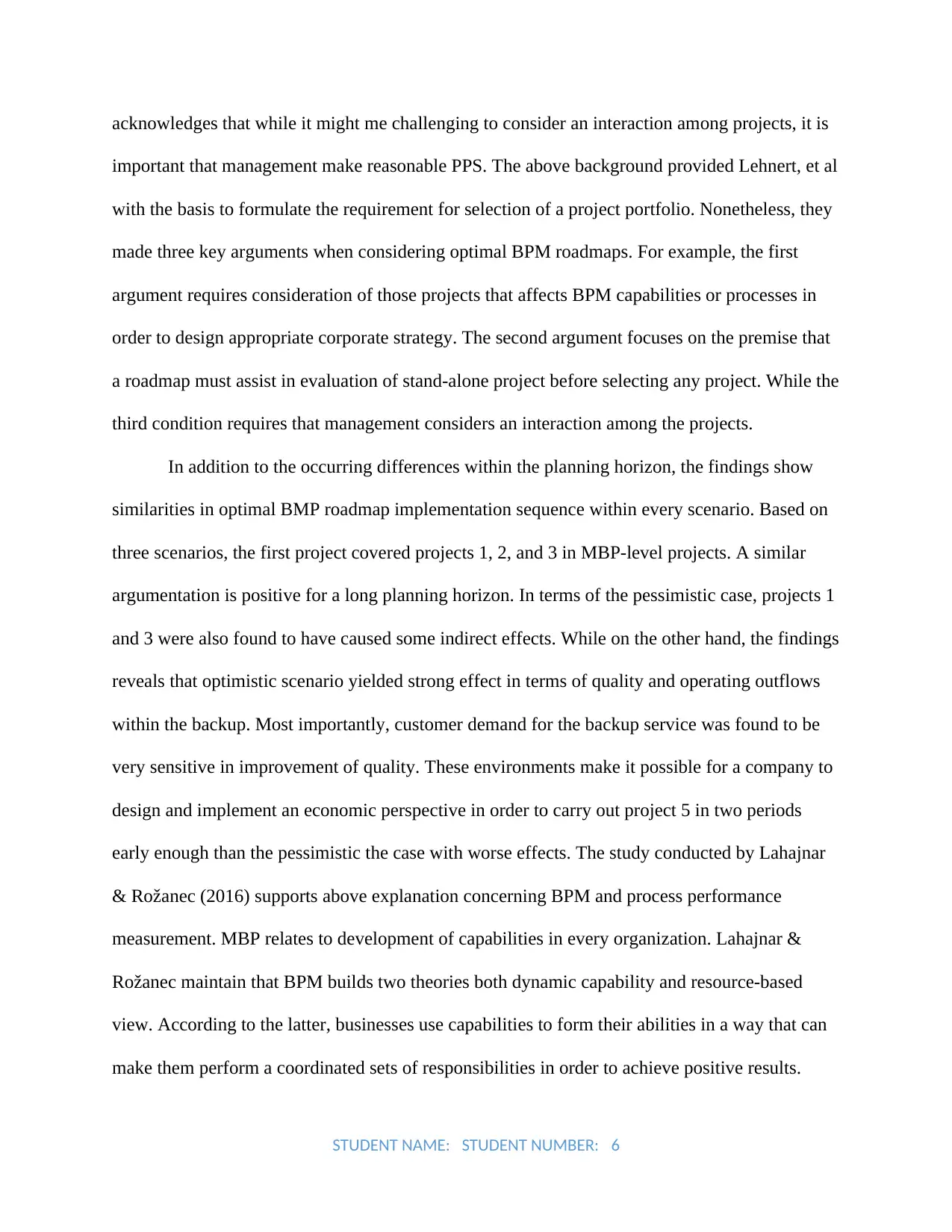
acknowledges that while it might me challenging to consider an interaction among projects, it is
important that management make reasonable PPS. The above background provided Lehnert, et al
with the basis to formulate the requirement for selection of a project portfolio. Nonetheless, they
made three key arguments when considering optimal BPM roadmaps. For example, the first
argument requires consideration of those projects that affects BPM capabilities or processes in
order to design appropriate corporate strategy. The second argument focuses on the premise that
a roadmap must assist in evaluation of stand-alone project before selecting any project. While the
third condition requires that management considers an interaction among the projects.
In addition to the occurring differences within the planning horizon, the findings show
similarities in optimal BMP roadmap implementation sequence within every scenario. Based on
three scenarios, the first project covered projects 1, 2, and 3 in MBP-level projects. A similar
argumentation is positive for a long planning horizon. In terms of the pessimistic case, projects 1
and 3 were also found to have caused some indirect effects. While on the other hand, the findings
reveals that optimistic scenario yielded strong effect in terms of quality and operating outflows
within the backup. Most importantly, customer demand for the backup service was found to be
very sensitive in improvement of quality. These environments make it possible for a company to
design and implement an economic perspective in order to carry out project 5 in two periods
early enough than the pessimistic the case with worse effects. The study conducted by Lahajnar
& Rožanec (2016) supports above explanation concerning BPM and process performance
measurement. MBP relates to development of capabilities in every organization. Lahajnar &
Rožanec maintain that BPM builds two theories both dynamic capability and resource-based
view. According to the latter, businesses use capabilities to form their abilities in a way that can
make them perform a coordinated sets of responsibilities in order to achieve positive results.
STUDENT NAME: STUDENT NUMBER: 6
important that management make reasonable PPS. The above background provided Lehnert, et al
with the basis to formulate the requirement for selection of a project portfolio. Nonetheless, they
made three key arguments when considering optimal BPM roadmaps. For example, the first
argument requires consideration of those projects that affects BPM capabilities or processes in
order to design appropriate corporate strategy. The second argument focuses on the premise that
a roadmap must assist in evaluation of stand-alone project before selecting any project. While the
third condition requires that management considers an interaction among the projects.
In addition to the occurring differences within the planning horizon, the findings show
similarities in optimal BMP roadmap implementation sequence within every scenario. Based on
three scenarios, the first project covered projects 1, 2, and 3 in MBP-level projects. A similar
argumentation is positive for a long planning horizon. In terms of the pessimistic case, projects 1
and 3 were also found to have caused some indirect effects. While on the other hand, the findings
reveals that optimistic scenario yielded strong effect in terms of quality and operating outflows
within the backup. Most importantly, customer demand for the backup service was found to be
very sensitive in improvement of quality. These environments make it possible for a company to
design and implement an economic perspective in order to carry out project 5 in two periods
early enough than the pessimistic the case with worse effects. The study conducted by Lahajnar
& Rožanec (2016) supports above explanation concerning BPM and process performance
measurement. MBP relates to development of capabilities in every organization. Lahajnar &
Rožanec maintain that BPM builds two theories both dynamic capability and resource-based
view. According to the latter, businesses use capabilities to form their abilities in a way that can
make them perform a coordinated sets of responsibilities in order to achieve positive results.
STUDENT NAME: STUDENT NUMBER: 6
⊘ This is a preview!⊘
Do you want full access?
Subscribe today to unlock all pages.

Trusted by 1+ million students worldwide
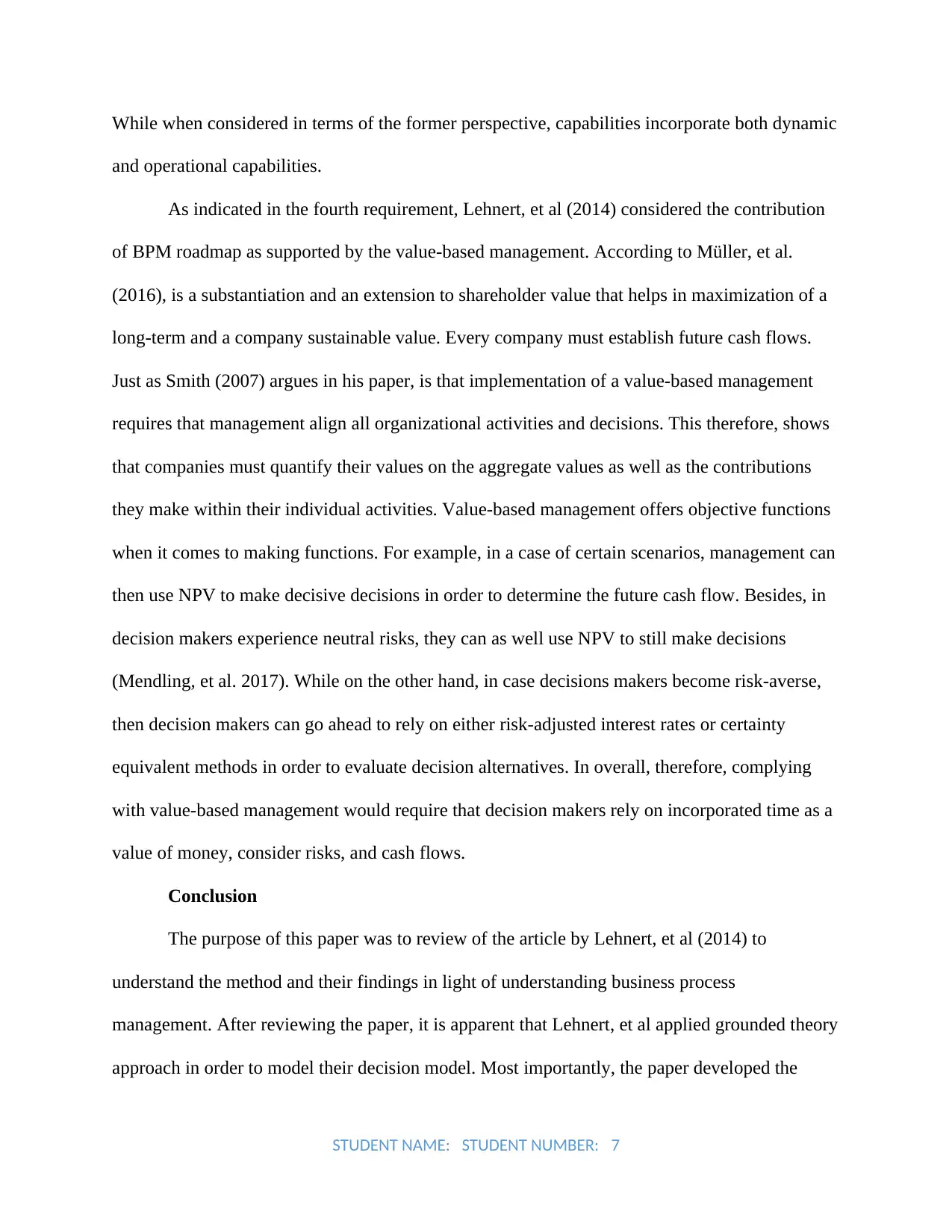
While when considered in terms of the former perspective, capabilities incorporate both dynamic
and operational capabilities.
As indicated in the fourth requirement, Lehnert, et al (2014) considered the contribution
of BPM roadmap as supported by the value-based management. According to Müller, et al.
(2016), is a substantiation and an extension to shareholder value that helps in maximization of a
long-term and a company sustainable value. Every company must establish future cash flows.
Just as Smith (2007) argues in his paper, is that implementation of a value-based management
requires that management align all organizational activities and decisions. This therefore, shows
that companies must quantify their values on the aggregate values as well as the contributions
they make within their individual activities. Value-based management offers objective functions
when it comes to making functions. For example, in a case of certain scenarios, management can
then use NPV to make decisive decisions in order to determine the future cash flow. Besides, in
decision makers experience neutral risks, they can as well use NPV to still make decisions
(Mendling, et al. 2017). While on the other hand, in case decisions makers become risk-averse,
then decision makers can go ahead to rely on either risk-adjusted interest rates or certainty
equivalent methods in order to evaluate decision alternatives. In overall, therefore, complying
with value-based management would require that decision makers rely on incorporated time as a
value of money, consider risks, and cash flows.
Conclusion
The purpose of this paper was to review of the article by Lehnert, et al (2014) to
understand the method and their findings in light of understanding business process
management. After reviewing the paper, it is apparent that Lehnert, et al applied grounded theory
approach in order to model their decision model. Most importantly, the paper developed the
STUDENT NAME: STUDENT NUMBER: 7
and operational capabilities.
As indicated in the fourth requirement, Lehnert, et al (2014) considered the contribution
of BPM roadmap as supported by the value-based management. According to Müller, et al.
(2016), is a substantiation and an extension to shareholder value that helps in maximization of a
long-term and a company sustainable value. Every company must establish future cash flows.
Just as Smith (2007) argues in his paper, is that implementation of a value-based management
requires that management align all organizational activities and decisions. This therefore, shows
that companies must quantify their values on the aggregate values as well as the contributions
they make within their individual activities. Value-based management offers objective functions
when it comes to making functions. For example, in a case of certain scenarios, management can
then use NPV to make decisive decisions in order to determine the future cash flow. Besides, in
decision makers experience neutral risks, they can as well use NPV to still make decisions
(Mendling, et al. 2017). While on the other hand, in case decisions makers become risk-averse,
then decision makers can go ahead to rely on either risk-adjusted interest rates or certainty
equivalent methods in order to evaluate decision alternatives. In overall, therefore, complying
with value-based management would require that decision makers rely on incorporated time as a
value of money, consider risks, and cash flows.
Conclusion
The purpose of this paper was to review of the article by Lehnert, et al (2014) to
understand the method and their findings in light of understanding business process
management. After reviewing the paper, it is apparent that Lehnert, et al applied grounded theory
approach in order to model their decision model. Most importantly, the paper developed the
STUDENT NAME: STUDENT NUMBER: 7
Paraphrase This Document
Need a fresh take? Get an instant paraphrase of this document with our AI Paraphraser
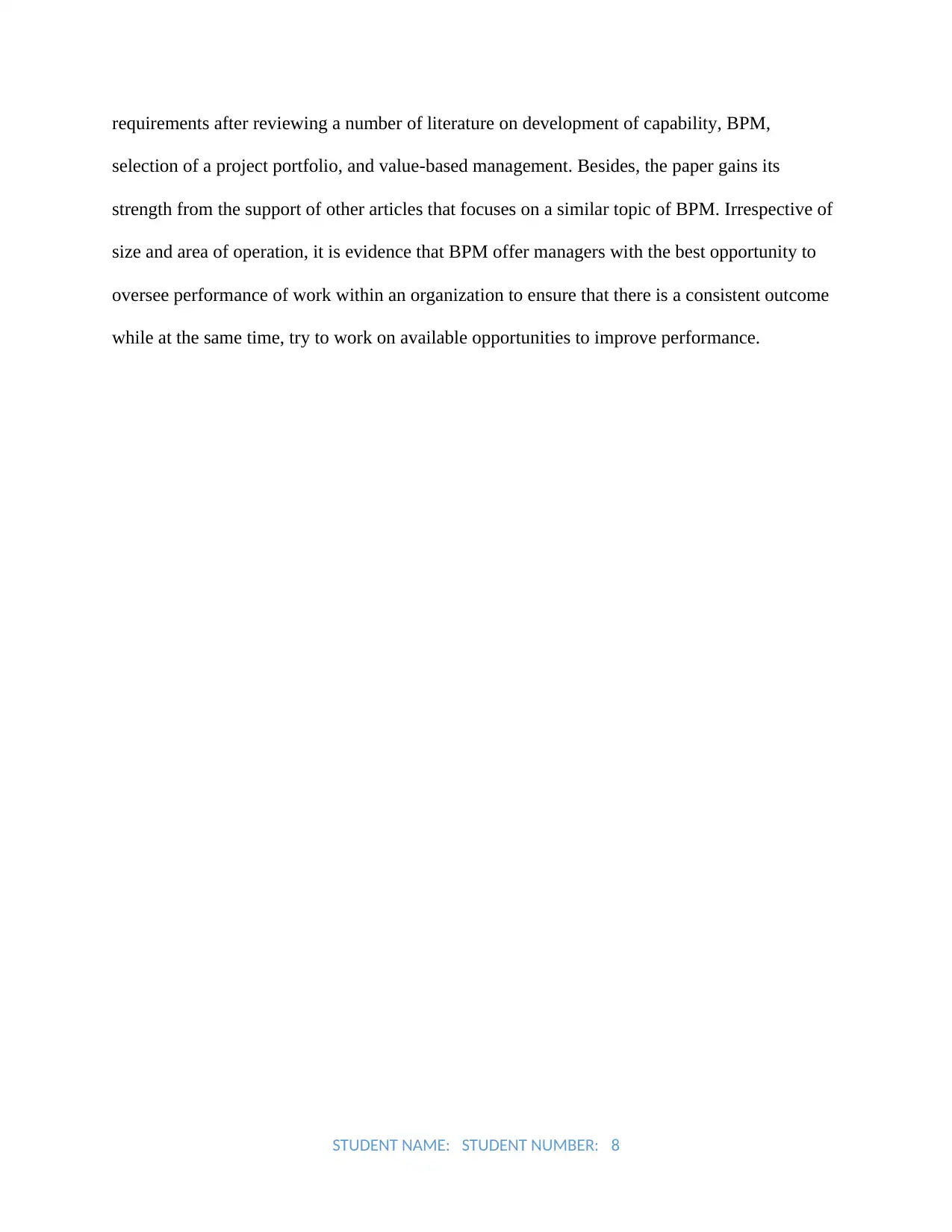
requirements after reviewing a number of literature on development of capability, BPM,
selection of a project portfolio, and value-based management. Besides, the paper gains its
strength from the support of other articles that focuses on a similar topic of BPM. Irrespective of
size and area of operation, it is evidence that BPM offer managers with the best opportunity to
oversee performance of work within an organization to ensure that there is a consistent outcome
while at the same time, try to work on available opportunities to improve performance.
STUDENT NAME: STUDENT NUMBER: 8
selection of a project portfolio, and value-based management. Besides, the paper gains its
strength from the support of other articles that focuses on a similar topic of BPM. Irrespective of
size and area of operation, it is evidence that BPM offer managers with the best opportunity to
oversee performance of work within an organization to ensure that there is a consistent outcome
while at the same time, try to work on available opportunities to improve performance.
STUDENT NAME: STUDENT NUMBER: 8
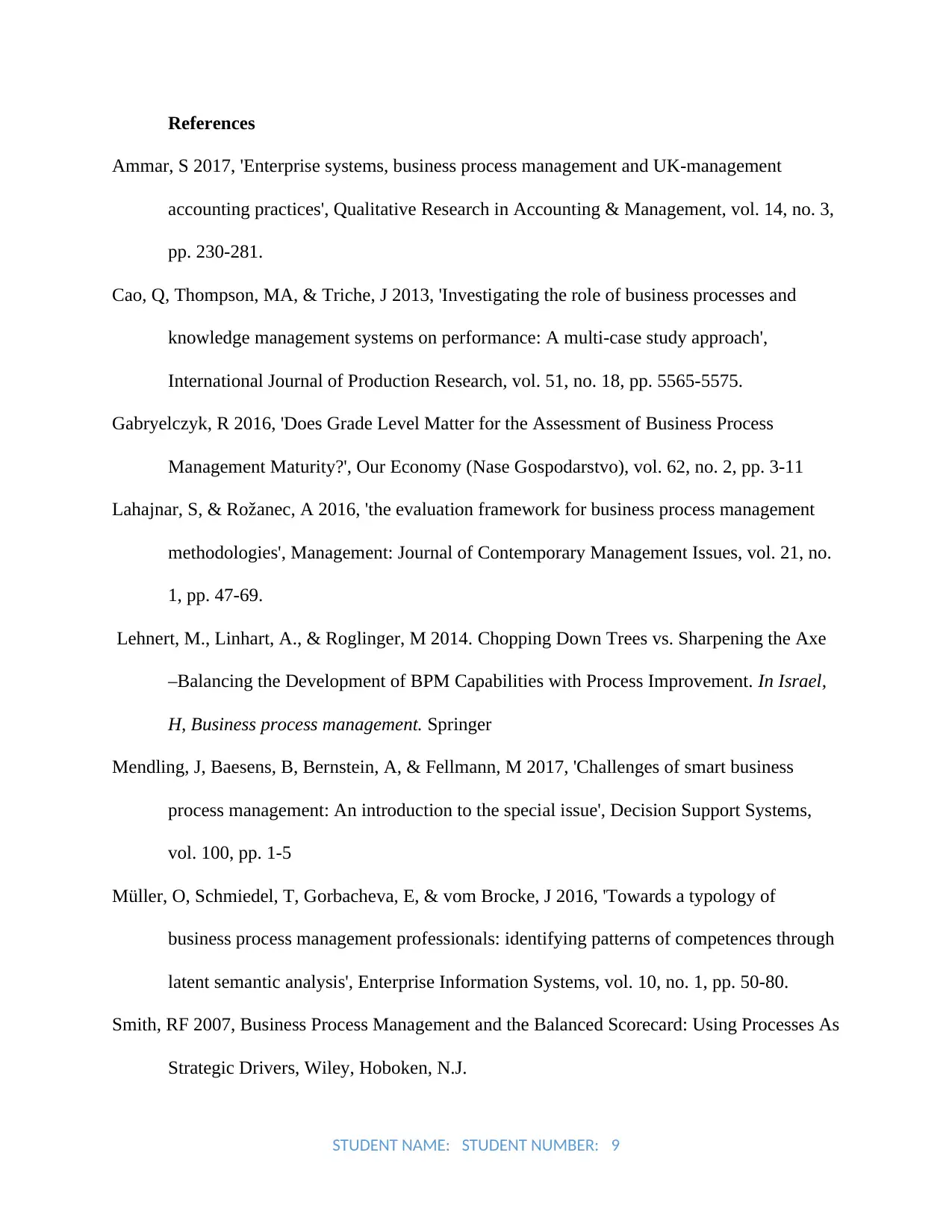
References
Ammar, S 2017, 'Enterprise systems, business process management and UK-management
accounting practices', Qualitative Research in Accounting & Management, vol. 14, no. 3,
pp. 230-281.
Cao, Q, Thompson, MA, & Triche, J 2013, 'Investigating the role of business processes and
knowledge management systems on performance: A multi-case study approach',
International Journal of Production Research, vol. 51, no. 18, pp. 5565-5575.
Gabryelczyk, R 2016, 'Does Grade Level Matter for the Assessment of Business Process
Management Maturity?', Our Economy (Nase Gospodarstvo), vol. 62, no. 2, pp. 3-11
Lahajnar, S, & Rožanec, A 2016, 'the evaluation framework for business process management
methodologies', Management: Journal of Contemporary Management Issues, vol. 21, no.
1, pp. 47-69.
Lehnert, M., Linhart, A., & Roglinger, M 2014. Chopping Down Trees vs. Sharpening the Axe
–Balancing the Development of BPM Capabilities with Process Improvement. In Israel,
H, Business process management. Springer
Mendling, J, Baesens, B, Bernstein, A, & Fellmann, M 2017, 'Challenges of smart business
process management: An introduction to the special issue', Decision Support Systems,
vol. 100, pp. 1-5
Müller, O, Schmiedel, T, Gorbacheva, E, & vom Brocke, J 2016, 'Towards a typology of
business process management professionals: identifying patterns of competences through
latent semantic analysis', Enterprise Information Systems, vol. 10, no. 1, pp. 50-80.
Smith, RF 2007, Business Process Management and the Balanced Scorecard: Using Processes As
Strategic Drivers, Wiley, Hoboken, N.J.
STUDENT NAME: STUDENT NUMBER: 9
Ammar, S 2017, 'Enterprise systems, business process management and UK-management
accounting practices', Qualitative Research in Accounting & Management, vol. 14, no. 3,
pp. 230-281.
Cao, Q, Thompson, MA, & Triche, J 2013, 'Investigating the role of business processes and
knowledge management systems on performance: A multi-case study approach',
International Journal of Production Research, vol. 51, no. 18, pp. 5565-5575.
Gabryelczyk, R 2016, 'Does Grade Level Matter for the Assessment of Business Process
Management Maturity?', Our Economy (Nase Gospodarstvo), vol. 62, no. 2, pp. 3-11
Lahajnar, S, & Rožanec, A 2016, 'the evaluation framework for business process management
methodologies', Management: Journal of Contemporary Management Issues, vol. 21, no.
1, pp. 47-69.
Lehnert, M., Linhart, A., & Roglinger, M 2014. Chopping Down Trees vs. Sharpening the Axe
–Balancing the Development of BPM Capabilities with Process Improvement. In Israel,
H, Business process management. Springer
Mendling, J, Baesens, B, Bernstein, A, & Fellmann, M 2017, 'Challenges of smart business
process management: An introduction to the special issue', Decision Support Systems,
vol. 100, pp. 1-5
Müller, O, Schmiedel, T, Gorbacheva, E, & vom Brocke, J 2016, 'Towards a typology of
business process management professionals: identifying patterns of competences through
latent semantic analysis', Enterprise Information Systems, vol. 10, no. 1, pp. 50-80.
Smith, RF 2007, Business Process Management and the Balanced Scorecard: Using Processes As
Strategic Drivers, Wiley, Hoboken, N.J.
STUDENT NAME: STUDENT NUMBER: 9
⊘ This is a preview!⊘
Do you want full access?
Subscribe today to unlock all pages.

Trusted by 1+ million students worldwide

Yousfi, A, Saidi, R, & Dey, A 2016, 'Variability patterns for business processes in BPMN',
Information Systems & e-Business Management, vol. 14, no. 3, pp. 443-467
STUDENT NAME: STUDENT NUMBER: 10
Information Systems & e-Business Management, vol. 14, no. 3, pp. 443-467
STUDENT NAME: STUDENT NUMBER: 10
1 out of 10
Related Documents
Your All-in-One AI-Powered Toolkit for Academic Success.
+13062052269
info@desklib.com
Available 24*7 on WhatsApp / Email
![[object Object]](/_next/static/media/star-bottom.7253800d.svg)
Unlock your academic potential
Copyright © 2020–2025 A2Z Services. All Rights Reserved. Developed and managed by ZUCOL.





